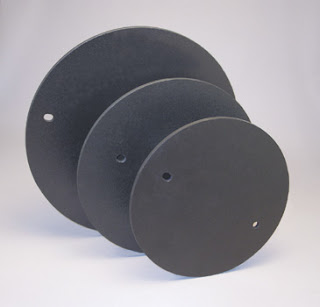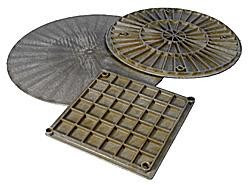The wobbly bat is a constant annoyance to the potter. It usually accompanies any attempt to use the common black bats, which look like this:
 The problem is that these holes get worn out and larger to the point where they don't fit the wheel pins any more. Then as you're putting pressure on one side of the form, it, well, wobbles, keeping you from centering the pot and making any progress on it. The wobbly bat sounds like this - thump, thump, thump, thump, thump, thump - until you're crazy with irritation!
The problem is that these holes get worn out and larger to the point where they don't fit the wheel pins any more. Then as you're putting pressure on one side of the form, it, well, wobbles, keeping you from centering the pot and making any progress on it. The wobbly bat sounds like this - thump, thump, thump, thump, thump, thump - until you're crazy with irritation!Now, what is the solution to this constant problem?
Paper towels. Stop what you're doing, get up, get some bits of paper towel, and cover the wheel pins with them. Then put the bat back on, and hopefully the paper will have tightened hole around the pin. Another solution is to try a different kind of bat, which I usually have more success with. This type looks like this:
 On to the hard clay. I splurged on a bag of fresh clay last night (as opposed to the stuff you recycle from the slip buckets and trimmings) and it was hard as a rock! I almost killed my hand trying to cone up and down. I returned the clay, but if you don't have that option, well, you might as well give up on throwing for the night. That's because there's no really good way to soften clay without some good old-fashioned time.
On to the hard clay. I splurged on a bag of fresh clay last night (as opposed to the stuff you recycle from the slip buckets and trimmings) and it was hard as a rock! I almost killed my hand trying to cone up and down. I returned the clay, but if you don't have that option, well, you might as well give up on throwing for the night. That's because there's no really good way to soften clay without some good old-fashioned time.One trick I do is cutting out a smallish piece (maybe a pound) and wedging it together with some throwing scraps that are too wet. But if you don't have any too-wet clay, your best option is to cut the clay up into even smaller pieces (a quarter to a half a pound), put them in a bag and spray the hell out of them with water. Then let them sit for a day and wedge them back together.



